If you’ve been trying to choose between Team-GPT and Claude Teams for your marketing workflow, welcome to the club. I’ve tested both with real projects (content planning, brainstorming, campaign outlines), and it became clear pretty quickly that they serve very different purposes.
Claude is great at writing with context. It’s thoughtful, detailed, and good at long-form tasks. But when it comes to working with a team, it falls short. Team-GPT, on the other hand, is built for collaboration. You get shared folders, project-level memory, and full control over which GPT model you want to use.
In this breakdown, I’ll walk you through how each one handles: team collaboration, content workflows, image generation, AI model options, and pricing. If you work in a team and use AI regularly for marketing, this might help you figure out which tool actually fits your day-to-day.
TL;DR
- Team-GPT is better suited for teams that need structured collaboration, such as shared folders, co-editing, and prompt management, all in one place.
- Claude Teams works well for teams focused on strategic tasks, long-form writing, and deep planning, thanks to its strong contextual memory and reasoning.
Team-GPT and Claude Teams: Similarities
Both Team-GPT and Claude Teams are designed with collaborative work in mind, and if you’re part of a team using AI for research, brainstorming, or content development, you’ll find quite a bit of functional overlap between the two.
- Collaborative Workspaces for Teams: Both platforms offer shared spaces where team members can collaborate, save chats, and organize projects. You can set up folders, tag ongoing work, and keep everything accessible, without the back-and-forth on email or Slack.
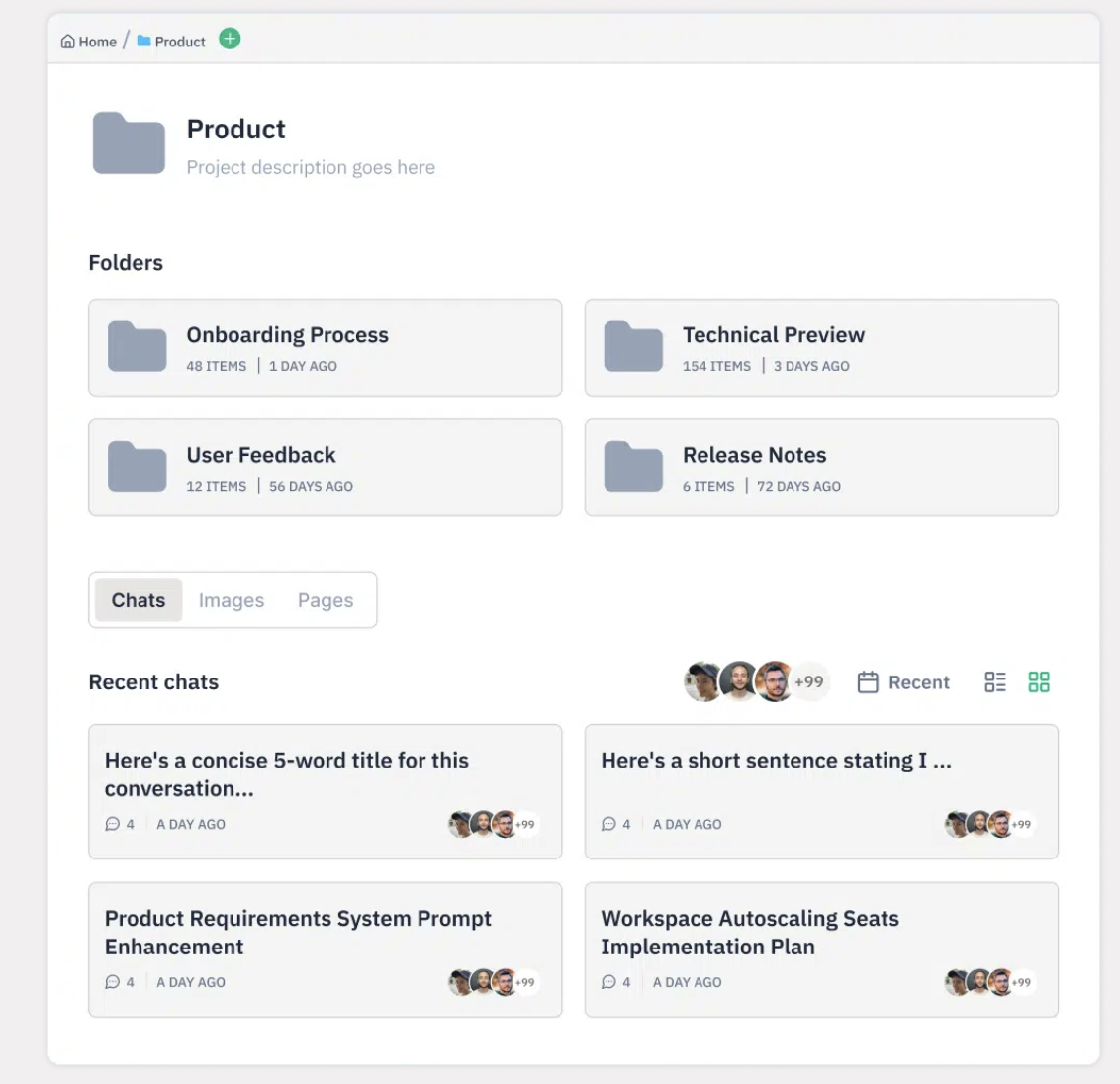
- Multi-Model Access: Neither platform limits you to one LLM. You can switch between models like ChatGPT-4 and Claude 3 depending on the task. This flexibility helps teams get better responses across different use cases: creative writing, analysis, summarisation, etc.
- File Upload and Deep Analysis: Whether it’s a lengthy PDF, a financial spreadsheet, or internal documentation, both tools allow uploads and give structured insights from the file. The AI can answer specific questions, summarise content, or help draft responses based on the file’s data.
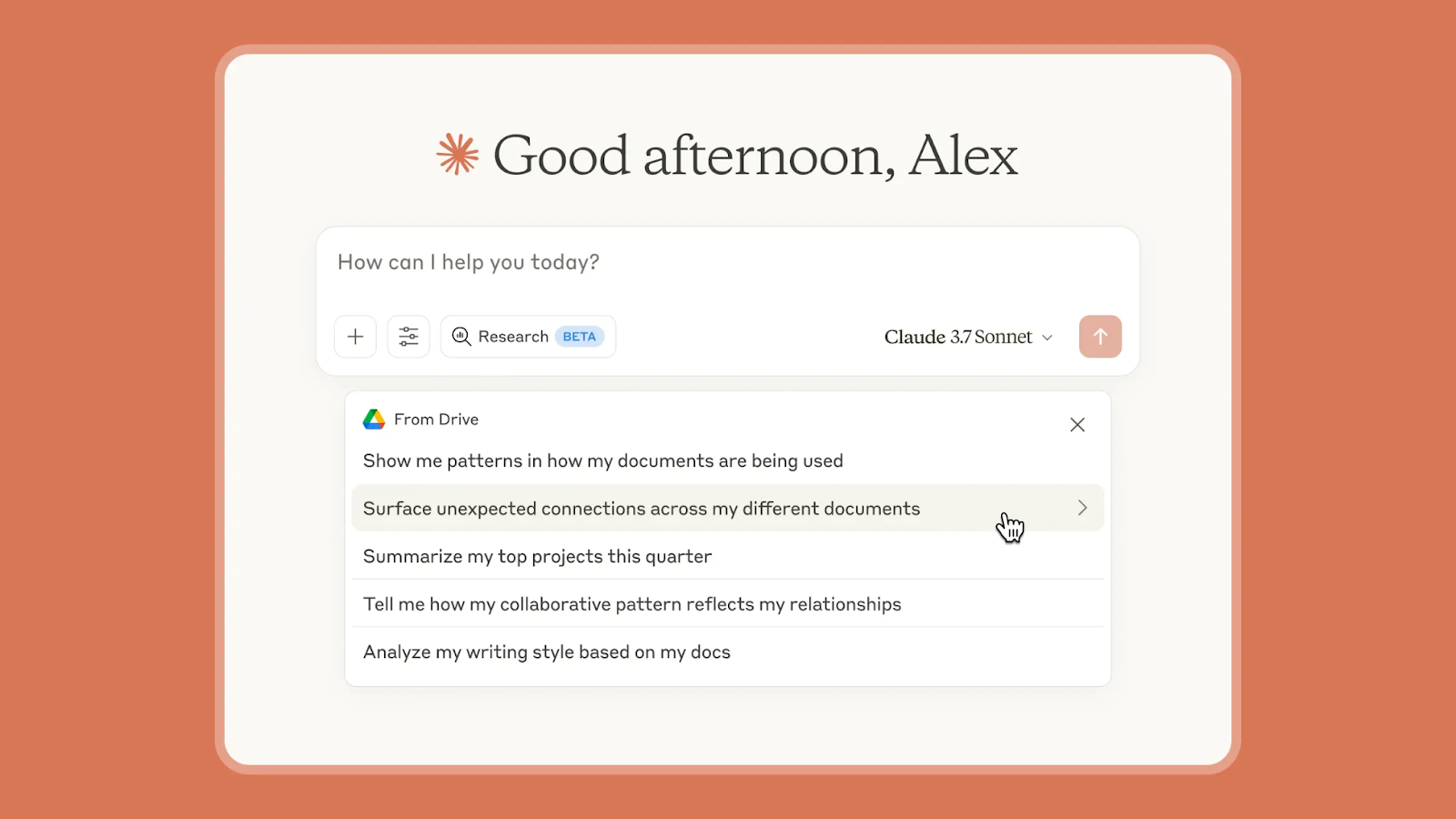
- Prompt Libraries and Templates: If your team has repeatable workflows, like writing briefs, replying to support queries, or creating reports, you can save prompts or templates on both platforms. It helps maintain quality and saves time across tasks.
- Enterprise-Ready Features: Both platforms are built with business needs in mind. They offer features like user permissions, secure data handling, and support for compliance needs (e.g., SOC 2, GDPR). Claude Teams, in particular, puts a stronger emphasis on privacy by default, while Team-GPT adds robust admin settings.
- Web Access and Live Search (in some tiers): Both tools support web browsing or have models that can pull in real-time data when needed. This is useful for research, checking current trends, or getting fresh information beyond training cutoffs.
- Team Management and Reporting: You get admin tools to manage members, assign roles, and monitor usage. Team-GPT tends to offer a more detailed activity view, while Claude Teams keeps things slightly more minimal but still functional for most small and mid-sized teams.
Features – Team-GPT vs Claude Teams
Both AI tools offer solid collaboration and AI capabilities, but they’re designed for slightly different team needs. Team-GPT focuses on project organization and shared workspaces, while Claude Teams leans into cognitive depth and planning support. Here’s how they compare on core features.
TL;DR:
- Team-GPT is ideal if your team needs shared folders, co-editing, and prompt management at scale.
- Claude Teams stands out when your work involves summarizing data, long-term planning, or analytical writing.
Now let’s walk through these tools’ features in more detail 👇
Team-GPT Features
Team-GPT is a fully collaborative, customizable AI workspace built specifically for teams. You can collaborate in real time, use and customize AI models, manage brand-specific knowledge, and track AI adoption across your team, without switching between apps or losing context. This makes it one of the best tools for agencies and in-house marketing teams looking to execute their campaign ideas successfully.
Feature #1. Build Custom Prompts with Prompt Builder
Team-GPT’s built-in Prompt Builder lets your team create, organize, and reuse prompts tailored to specific use cases, without relying on scattered docs or Slack messages. Whether you’re drafting a marketing email, analyzing user feedback, or generating product descriptions, you can build prompt templates and share them with your team in just a few clicks.
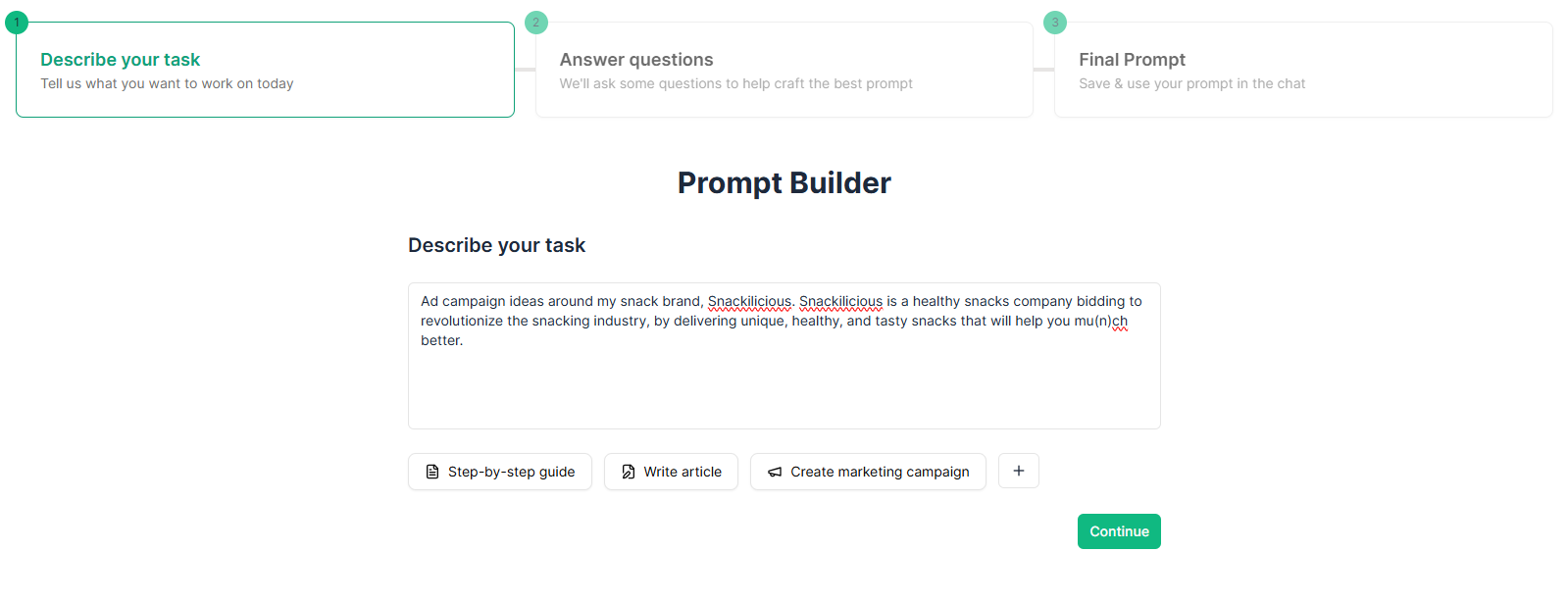
You can also tag and group prompts by department or objective, making it easy for everyone to find what they need and stay consistent in output quality. It’s especially useful for onboarding new team members—you can give them instant access to proven prompts, no training required.
Feature #2. Full Control Over AI Models and Customization
Team-GPT supports a wide range of AI models, including ChatGPT-4o, Claude, Gemini, LLaMA, and even custom models through API keys. You don’t have to stick with just one. You can switch models mid-chat based on your content needs: long-form copy, brand voice testing, or even technical writing.
More importantly, Team-GPT lets you customize each model to fit your brand tone, voice, and team goals. Here’s how:
- It Learns From Your Team’s Behavior: As you and your team use shared prompts, instructions, and feedback, Team-GPT automatically adapts, getting better at understanding what your team needs.
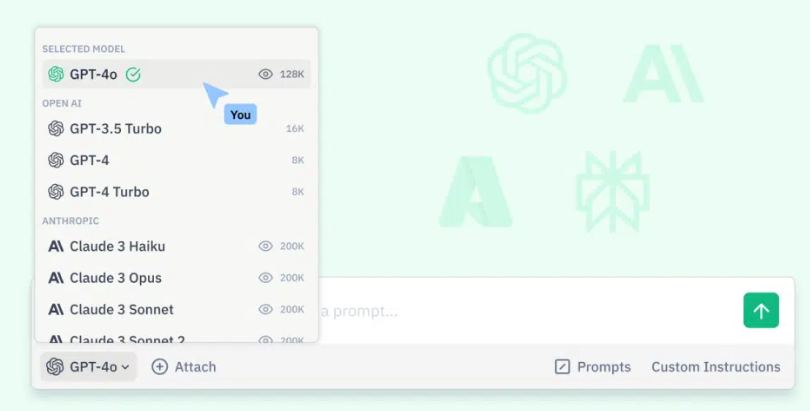
- You Can Build a Reusable Prompt Library: Save prompts for campaign planning, content writing, ad copy, or persona development. You can organize them per project, team, or objective.

- Deploy Custom LLMs (Large Language Models): On the Enterprise plan, you can bring your own AI models and integrate them directly into your workflow.
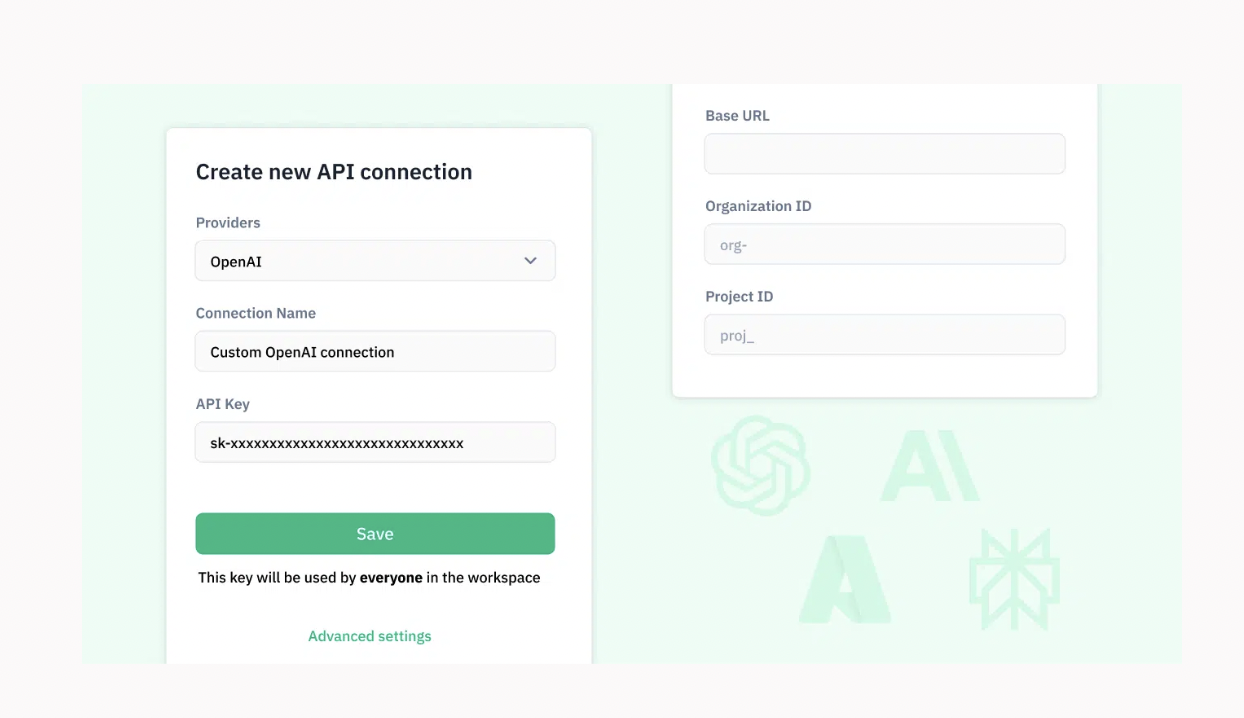
Feature #3. Purpose-Built AI Toolkit for Marketing Teams
Team-GPT isn’t limited to just chat. It includes a powerful toolkit designed to support marketing teams across all campaign stages. Here’s what you get:
- 100+ Pre-built Marketing Workflows: These include campaign briefs, ad copy templates, product descriptions, blog post starters, and more. You can edit them or create your own.
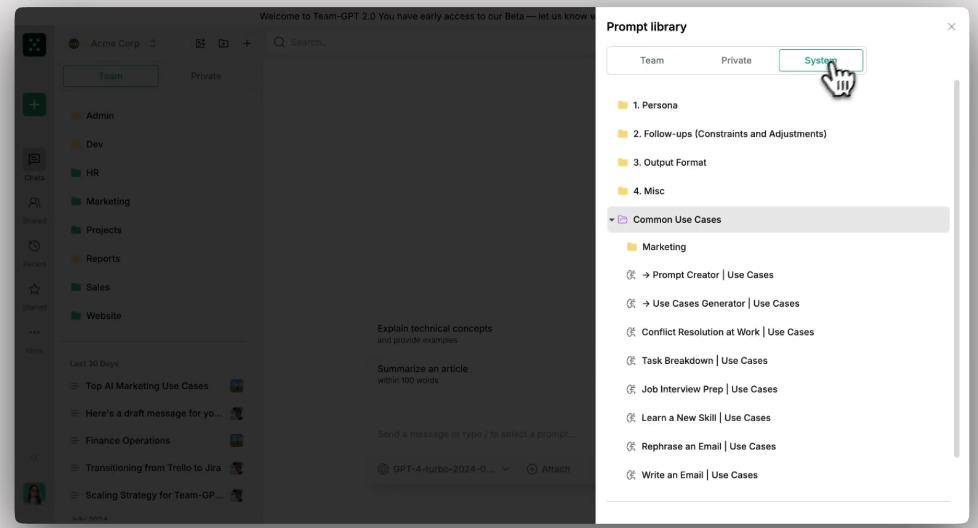
- AI Personas: Turn the AI into a marketing strategist, content writer, SEO expert, or even a creative director based on your needs.

- AI Pages: You can turn any chat into an editable document using Pages. You can edit, comment, and collaborate in real time, just like you would in a shared doc. Once ready, you can export the content to formats like PDF, Google Docs, or Word.

- Custom Prompt Libraries: Save commonly used prompts (e.g., email nurture sequences or A/B ad copy formats) and share them across teams.
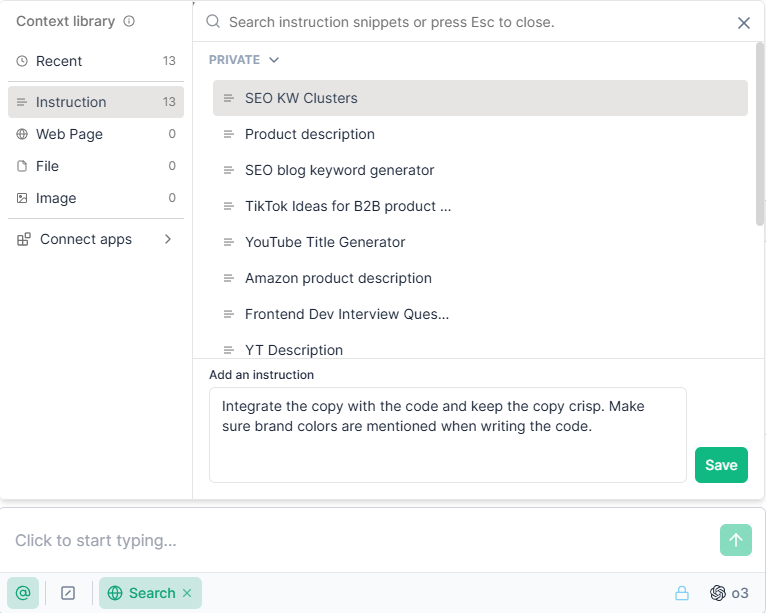
- Image Generation with DALL·E: Generate visual creatives like social banners or ad visuals directly from within the platform.
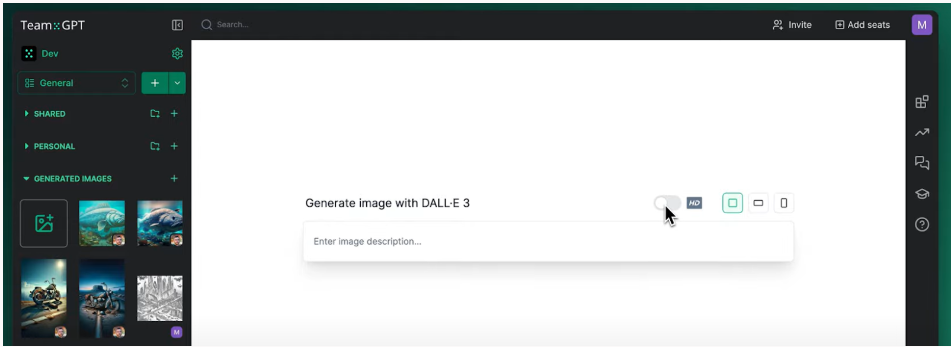
- Doc and Image Analysis: Upload files and get quick summaries, editing suggestions, and AI-written rewrites, ideal for analyzing briefs, campaign docs, or client materials.
- Seamless Integration: Team-GPT connects with tools like Google Drive, Notion, OneDrive, and SharePoint, so you can import brand materials, campaign docs, or reporting templates directly into your AI workspace.

Feature #4. Shared Project Knowledge for On-Brand AI Output
You can upload brand guidelines, campaign briefs, customer personas, and competitor research into a shared knowledge base per project. The AI references this automatically, keeping your outputs consistent.
Each team member can:
- Add and update project knowledge.
- Link documents, assets, and brand voice guidelines.
- Use pre-set instructions to steer tone, structure, and messaging.
This is especially useful for agencies managing multiple brands or in-house teams launching multi-channel marketing campaigns.
Feature #5. Track AI Usage
Team-GPT provides deep visibility into how your team is using AI. Admins and managers can track:
- AI adoption by users.
- Prompt usage by campaign or task.
- Chat length, engagement, and output volume.
- Token usage per user (helpful for budget tracking).
- Which campaigns or models are producing the best results.
This helps you identify high-performing workflows or bottlenecks, support teammates who are struggling with prompt quality, and optimize usage across roles (e.g., content vs. design vs. strategy).

Team-GPT is the right choice if you:
✅ Work in a collaborative marketing team that juggles campaigns, clients, and content formats.
✅ Want to manage all your AI work in one place: copy, visuals, docs, and analytics.
✅ Need the ability to switch AI models depending on task, tone, or format.
✅ Want clear insights into how your team is using AI, what’s working, and what needs improvement.
✅ Prefer to keep your workflow secure with enterprise-grade permissions and privacy controls.
Team-GPT isn’t the best option if you:
❌ Only need a basic AI chatbot for one-person tasks or idea generation.
❌ Don’t need team collaboration, multi-model switching, or shared project knowledge.
❌ Prefer a mobile or desktop app (Team-GPT is web-based for now).
P.S. Want to learn more about how you can integrate Team-GPT into your marketing strategies? Join the waitlist for the only marketing AI course you’ll need.
Claude Teams Features
Claude Teams is Anthropic’s collaborative AI workspace built for teams that need secure, scalable, and context-aware assistance across their workflows. It’s designed to support everything from content creation and technical analysis to brainstorming and automation, powered by the Claude 3 model family.
Feature #1: Shared Workspaces and Team Collaboration
Claude Teams offers dedicated, secure workspaces where teams can collaborate in real time. You can organize conversations into Projects, share best prompts and chats, and keep everything, from documents to decisions, in one centralized place. This structure makes it easy for teams to stay aligned, iterate together, and build institutional knowledge over time.

Feature #2: Project-Based Knowledge Grounding
Within each Project, teams can upload internal documentation, brand guidelines, strategy decks, datasets, or code. Claude uses this context to generate more accurate, brand-aligned outputs. It helps ensure the AI stays grounded in your company’s voice and goals, especially useful for marketing, legal, or product teams.
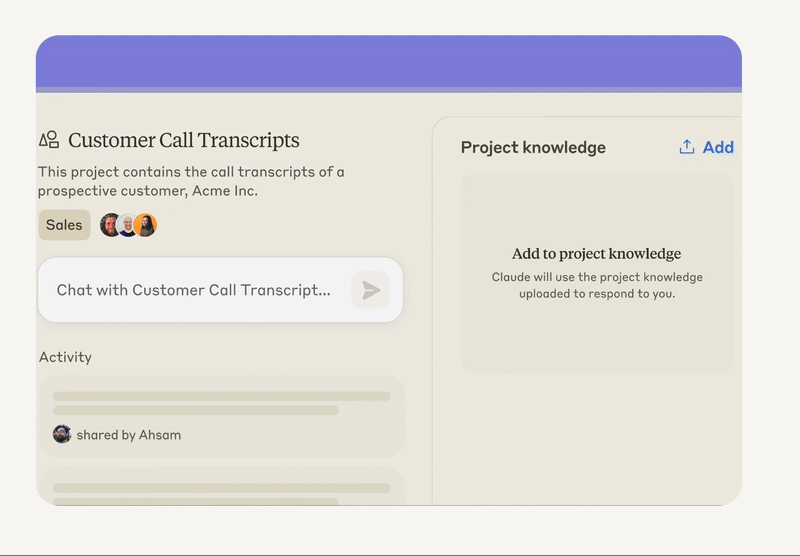
Feature #3: Artifact Creation and Collaboration
Claude can generate “Artifacts” directly inside a chat, such as documents, tables, code, or visuals. These outputs live within your Project and can be reviewed, edited, or built on by your team. It removes the need to jump between tools and makes collaborative drafting much faster.
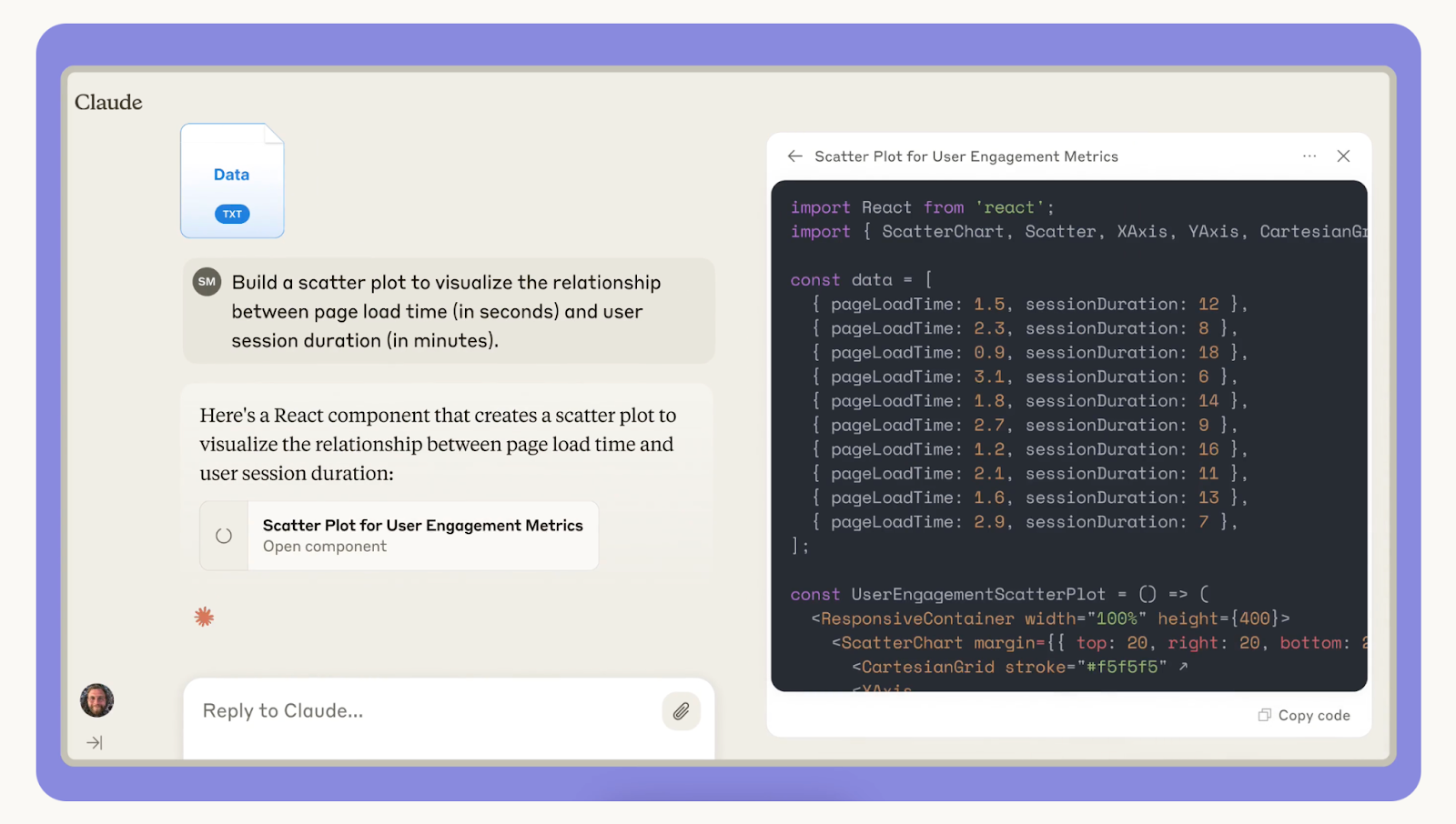
Feature #4: Claude 3 Model Access with Large Context
You get access to Anthropic’s Claude 3 family (Opus, Sonnet, and Haiku), each suited to different types of tasks. Opus, in particular, supports long-context work (200K+ tokens), making it ideal for reviewing lengthy contracts, product documentation, or technical specs. Sonnet and Haiku are great for faster, more routine tasks.
Feature #5: Multimodal & Mobile Capabilities
Claude can handle image input, so you can upload graphs, screenshots, or design mockups and ask questions about them. On iOS, the Claude Teams app supports real-time collaboration, synced chat history, image uploads, and mobile-first workflows, useful for field teams or hybrid environments.
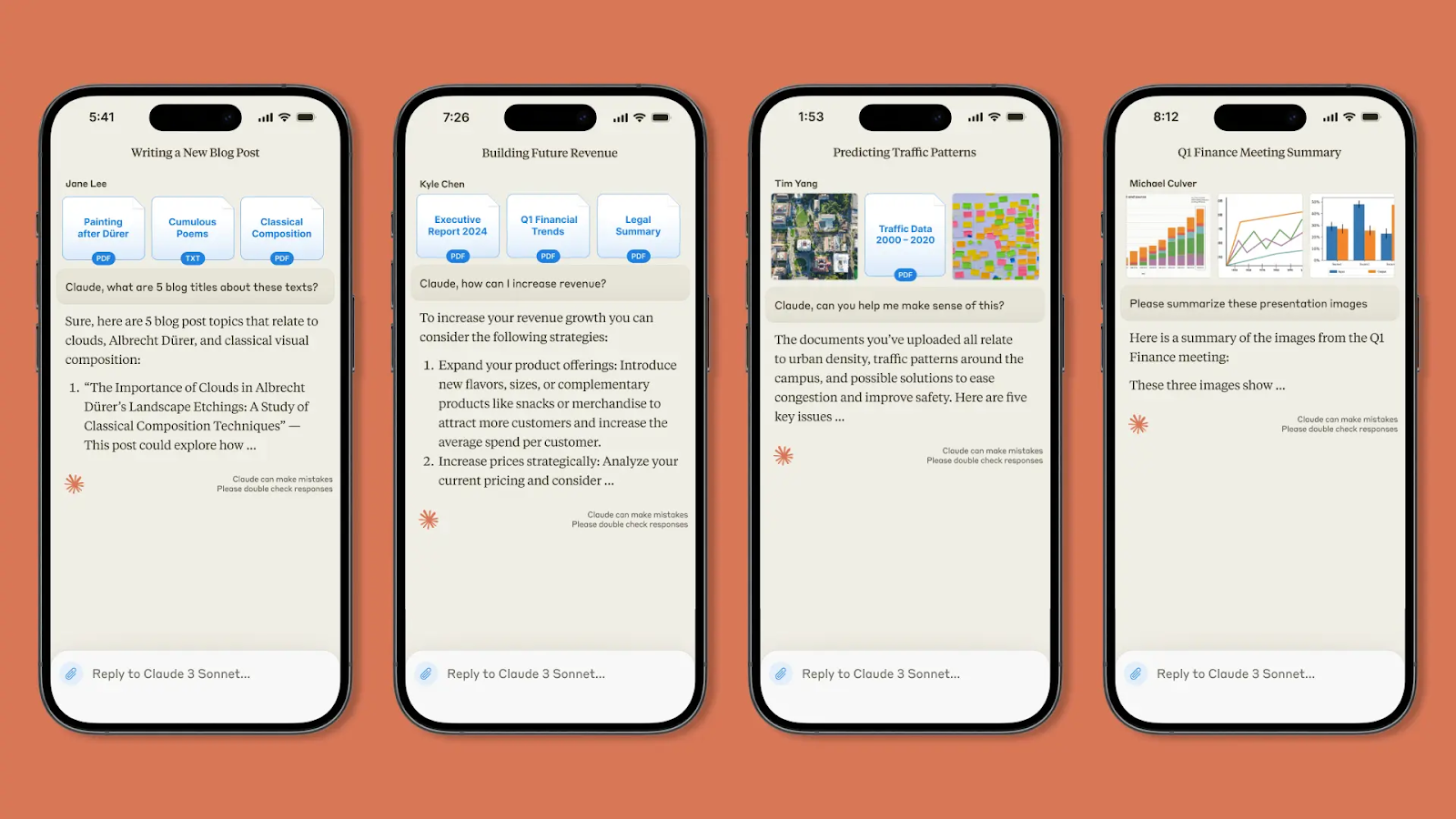
Claude Teams is the right choice if you:
✅ Want to collaborate on AI outputs inside structured, shared workspaces.
✅ Need long-context understanding for detailed documents or complex workflows.
✅ Prefer an AI that stays compliant with your company’s data, guidelines, or tone.
✅ Need secure, enterprise-ready features with privacy by design.
Claude Teams isn’t the right choice if you:
❌ Need to host your own models or fully control model deployment.
❌ Rely heavily on non-Anthropic models or want a bring-your-own-LLM setup.
❌ Are looking for highly customizable or developer-first AI infrastructure.
Winner: Team-GPT wins when it comes to team-focused features. It offers shared folders, real-time co-editing, prompt libraries, and document-style Pages that make team workflows smooth. While Claude Teams has powerful reasoning and memory, its collaboration tools aren’t as structured or flexible as what Team-GPT offers out of the box.
Team Collaboration Capabilities- Team-GPT vs Claude Teams
Both Team-GPT and Claude Teams offer strong collaboration features, but they’re optimized for slightly different workflows. Team-GPT emphasizes flexible, real-time teamwork across multiple models and deliverables, while Claude Teams excels at deep, context-aware collaboration inside tightly scoped projects.
Here’s an in-depth comparison of the two:
TL;DR:
- Team-GPT is built for structured, cross-model collaboration with live co-editing, shared Pages, and centralized team oversight.
- Claude Teams offers context-rich project spaces with massive memory, artifact generation, and grounded collaboration on documents and code.
Team-GPT’s Collaboration Features
Team-GPT is designed for hands-on, fast-paced teamwork. It turns AI chats into dynamic, collaborative workspaces where teams can create, iterate, and deliver together.
Here’s how Team-GPT supports active team collaboration:
- Real-Time Collaboration on Prompts and Pages: Teams can brainstorm, co-write, and edit content directly inside chats or Pages, like working in a shared Google Doc, but AI-powered.
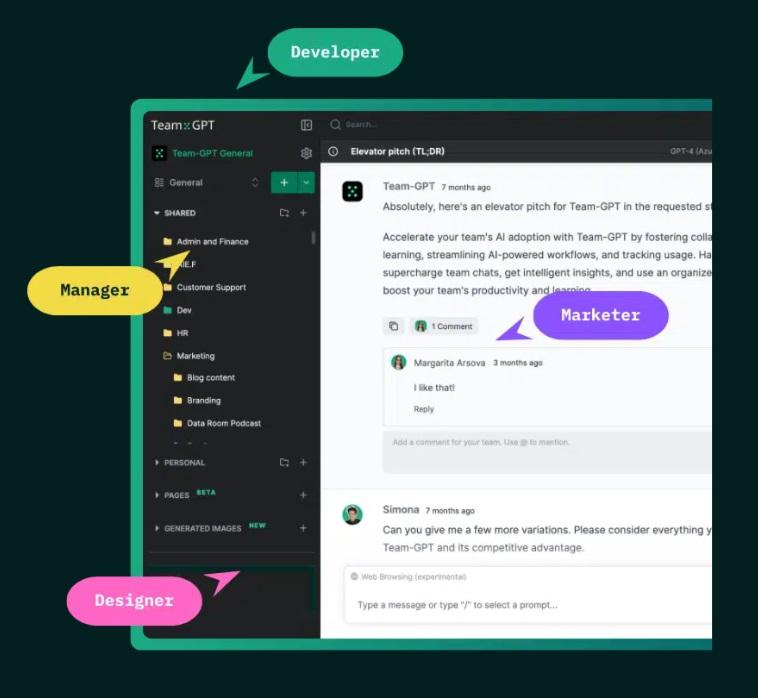
- Projects with Persistent Knowledge Bases: Upload brand guidelines, research, strategy docs, and more. The AI uses this context automatically across all chats within the project.
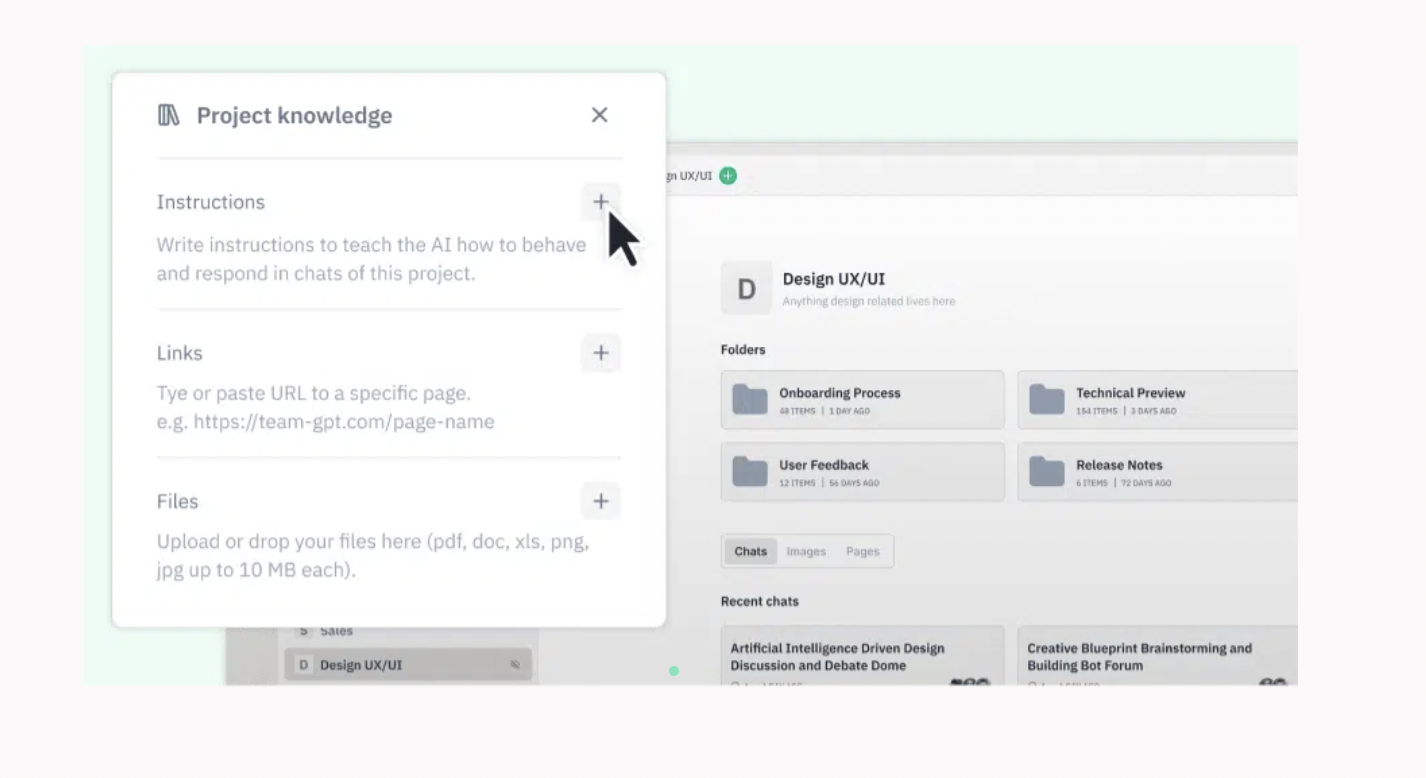
- Cross-Model Flexibility: Use OpenAI’s ChatGPT-4, Anthropic’s Claude, Google’s Gemini, and open-source models like Mistral, all in the same workspace. Switch or compare models based on the task.
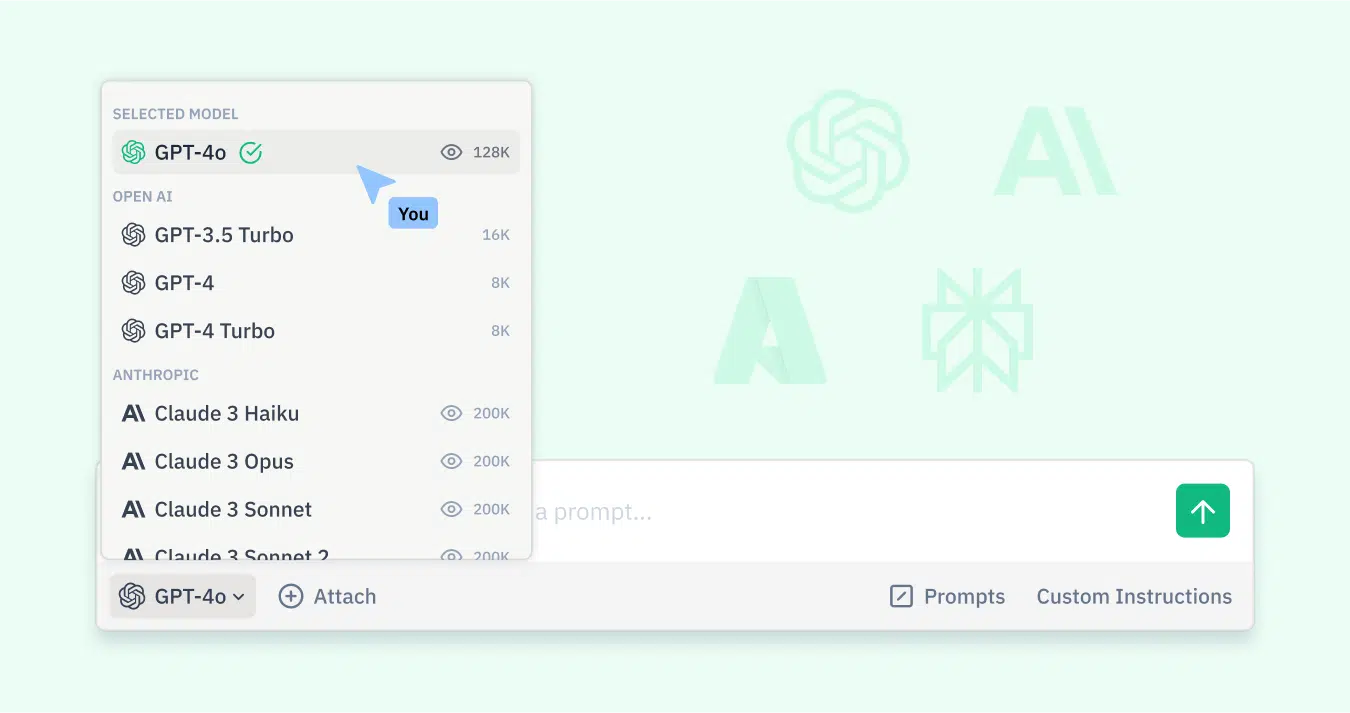
- Fork Conversations and Track Iterations: Branch off from existing chats to test new ideas without losing the original context. Great for exploring different angles or revisiting drafts.
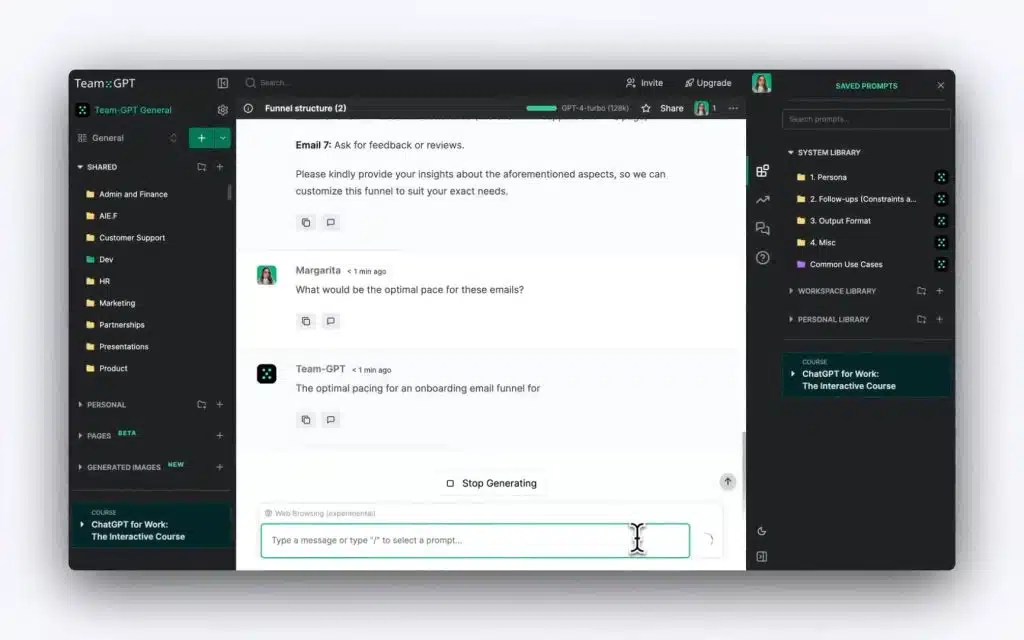
- Team Oversight and Learning: Admins can view team activity, leave inline feedback, and even build AI learning paths to train teammates or onboard new hires.
- Organized Workspace Navigation: Projects, folders, tags, and color-coded structures help teams navigate large volumes of conversations, prompts, and outputs.

Team-GPT is the right choice if you:
✅ Need real-time collaboration on prompts, drafts, or AI-generated docs.
✅ Want to mix and match models in the same project (Claude, ChatGPT-4, Gemini, etc.).
✅ Work on deliverables like campaign briefs, reports, or research as a team.
✅ Value visibility into team activity and shared learning.
✅ Need reusable prompt templates and rich project organization.
Team-GPT isn’t the best option if you:
❌ Only use a single model and don’t need team-level workflows.
❌ Prefer minimal tools without folders, dashboards, or permissions.
❌ Work solo and don’t require structured collaboration or shared spaces.
Claude Team’s Collaboration Features
Claude Teams is structured around Projects, a dedicated AI workspace where your team uploads knowledge, interacts with Claude, and co-creates “Artifacts” like docs, diagrams, or code snippets.
Here’s how Claude Teams supports collaboration:
- Context-Rich Project Workspaces: Teams upload documents, brand assets, product specs, and more. Claude references this content in every chat within the project for highly relevant, grounded responses.
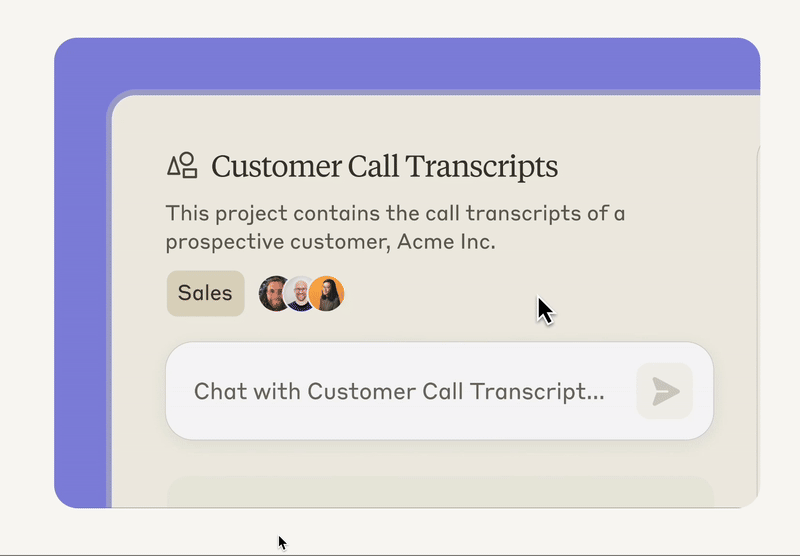
- Real-Time Co-Chatting and File Sharing: Multiple teammates can join chats, ask questions, and iterate with Claude together.
- Artifacts: Claude generates live, editable assets, like documents, charts, code blocks, or copy, that sit alongside the chat. Team members can collaborate on these inside the project space.

- Custom Instructions and Role-Based Responses: Set Claude to respond in a specific tone or role (e.g., “speak like a product marketer” or “act as legal counsel”) per project.
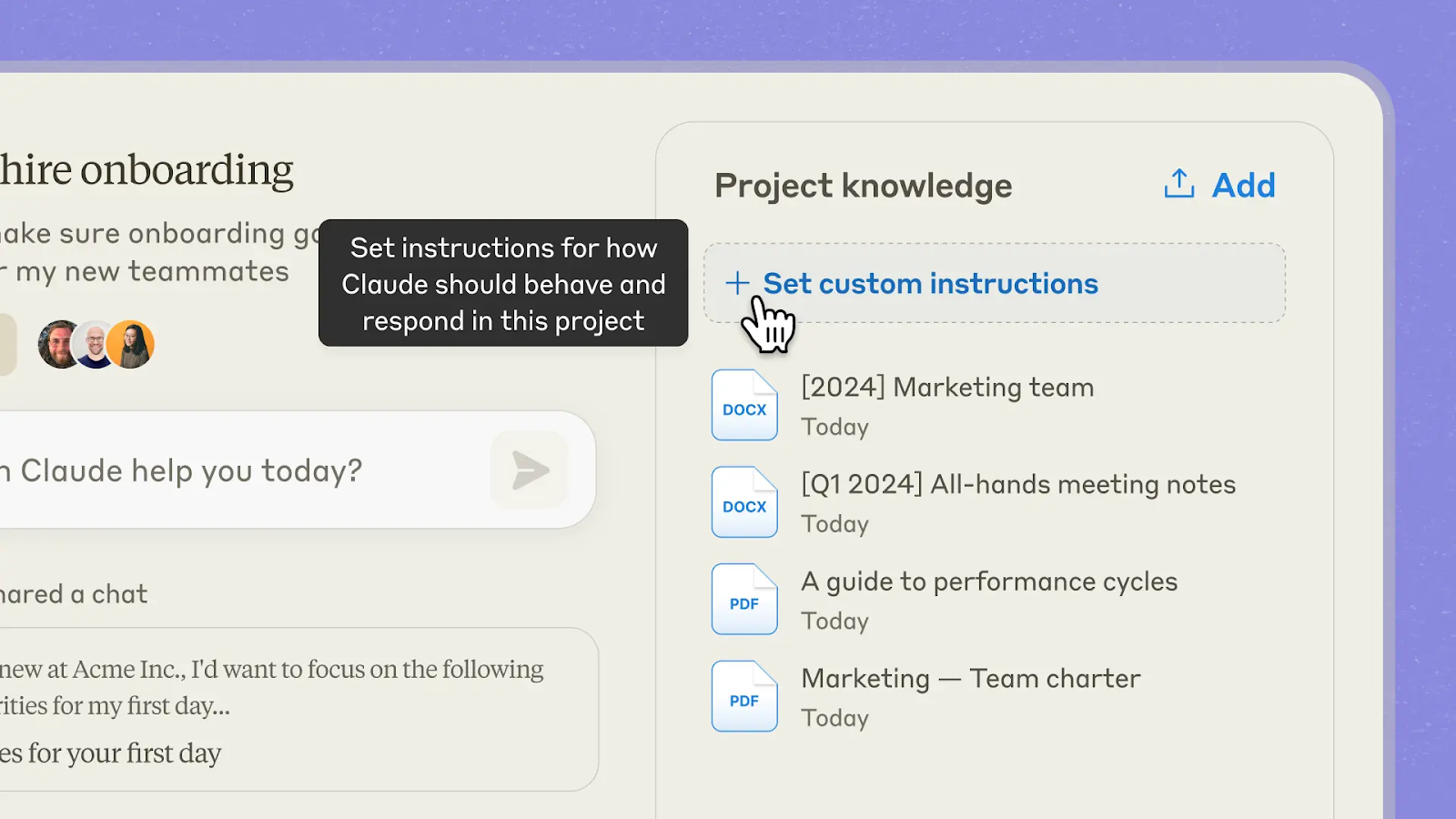
- 200K Token Memory: Claude 3.5 Sonnet supports huge context windows, making it perfect for reviewing long documents, codebases, or research.
- Activity Feed and Best Chat Sharing: Teams can promote standout chats and learn from each other’s best uses of the model.

- Security and Access Control: Strong permissions, role-based access, and data isolation ensure enterprise-grade privacy.
Claude Teams is the right choice if you:
✅ Want highly contextual AI grounded in your documents, brand, or code.
✅ Need long-context understanding (e.g., contracts, product specs, or reports).
✅ Prefer project-based work with structured, artifact-driven outputs.
✅ Want AI to respond in different roles or voices depending on the task.
✅ Value privacy, security, and compliant collaboration.
Claude Teams isn’t the best option if you:
❌ Need multi-model workflows or custom AI model integration.
❌ Prefer fast, lightweight co-editing tools over structured Projects.
❌ Rely on open-ended creative exploration or live multi-threading across teams.
Winner: While Claude Teams shines in project-specific, document-grounded collaboration, Team-GPT takes the win for flexibility, real-time co-creation, and multi-model teamwork. Its unified interface, forkable chats, Pages, and cross-model access give teams more creative control and faster iteration, especially valuable for marketing, research, and content-driven teams.
Pricing – Team-GPT vs Claude Teams
Both Team-GPT and Claude Teams start at $25 per user per month (billed annually), but the structure and value of each plan differ based on your team’s priorities; whether it’s multi-model access, deeper collaboration tools, or enterprise-grade scaling.
TL;DR:
- Team-GPT offers multi-model access (OpenAI, Claude, Gemini, etc.) at all tiers and scales well with advanced features like API flexibility and private cloud deployment.
- Claude Teams is simpler, offering centralized access to the Claude model family with higher usage limits and basic admin tools, but lacks multi-model support or deep customization.
Team-GPT Pricing
Team-GPT offers flexible plans designed to fit both small marketing teams and enterprise-scale organizations:
- Business ($25 per user per month):
Ideal for smaller teams that want structured collaboration:- Multi-model access: ChatGPT-4, Claude, Gemini, and more.
- Shared AI workspaces and project folders.
- Usage reports and analytics.
- Email and chat support.
- Growth ($35 per user per month):
Best for scaling teams that need flexibility:- Everything in Business, plus:
- Unlimited usage of all supported AI models.
- Access to Gemini, DeepSeek, and Perplexity.
- Bring Your Own API keys.
- Third-party integrations (Slack, Google Drive, etc.).
- Tailored onboarding and priority support.
- Enterprise (Custom Pricing):
For large organizations with advanced security and control needs:- Everything in Growth, plus:
- Unlimited workspaces.
- Private cloud or on-prem deployment.
- Add your own custom models.
- Premium Key Account Management.
- SSO, advanced governance, and audit logs.

Claude Teams Pricing
Claude Teams is priced at $25 per user per month (billed annually) and offers a single, straightforward plan with a few enterprise-oriented benefits:
- More usage than Claude Pro users.
- Access to Claude 3.5/4 models with a 200K-token context window.
- Admin tools for access and billing control.
- Centralized Projects and collaboration features.
- Early access to new features and priority system access.
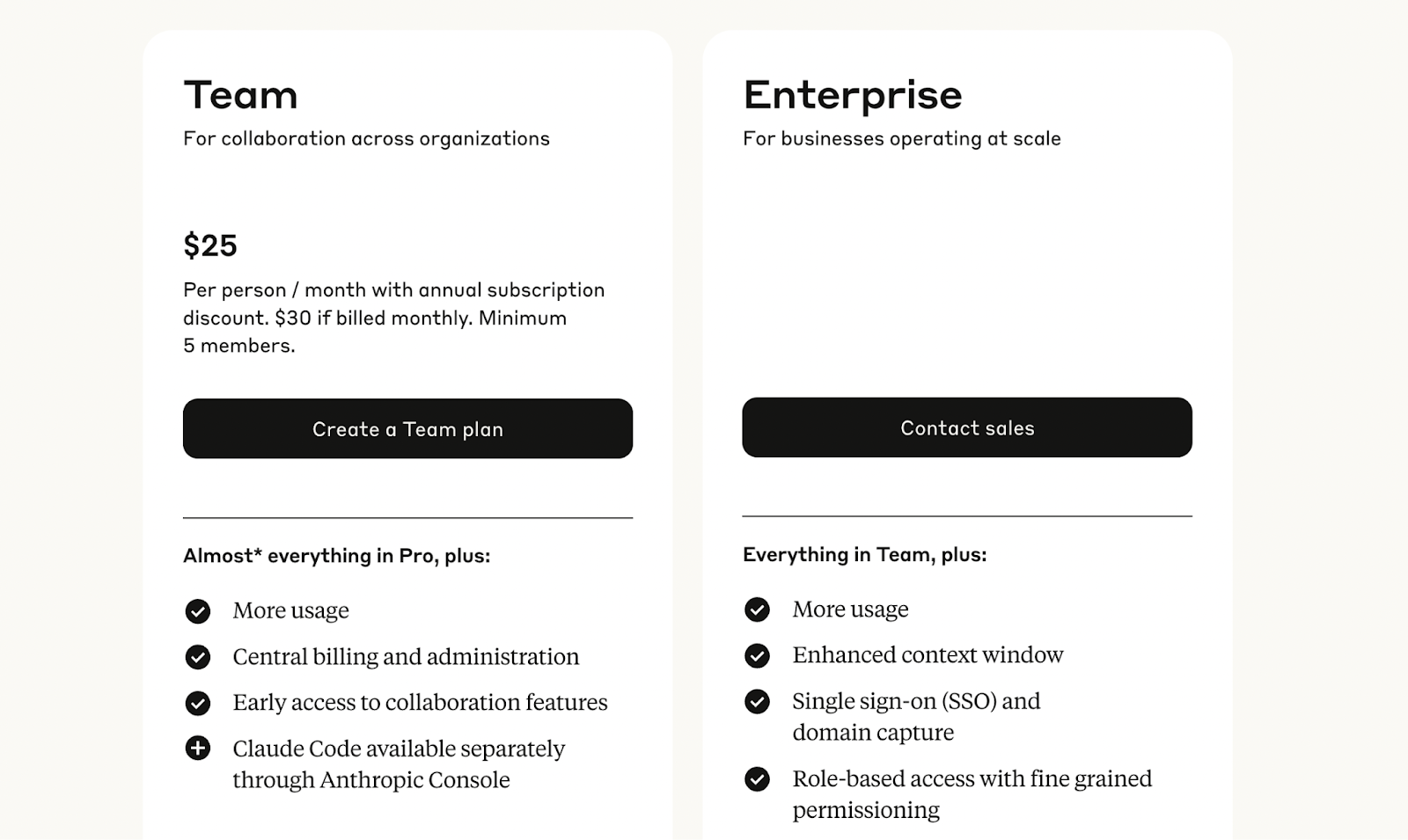
Winner: Team-GPT wins on flexibility and value. At the same $25 entry price, it offers access to multiple top-tier models, full collaborative workspace features, and project customization. Claude Teams is solid if your team is committed to the Claude ecosystem, but it lacks the variety of tools, integrations, and customization that Team-GPT provides out of the box.
What are Customers Saying about Team-GPT vs Claude Teams?
I reviewed feedback from platforms like G2 and Reddit to understand how users feel about Team-GPT and Claude Teams. Here’s what stands out:
TL;DR:
- Users love Team-GPT for how easy it makes team collaboration, especially with its folder-based organization and prompt-sharing features. While it improves daily workflows, users do point out minor AI response inconsistencies.
- Claude Teams wins praise for its reasoning capabilities, especially around data, from parsing tables to planning tasks. However, the steep five-seat entry requirement has frustrated some potential users who prefer smaller setups.
Team-GPT Reviews
What users love:
- Organized Collaboration: Users consistently highlight how Team-GPT’s interface makes it easy to organize projects. You can group conversations and prompts into folders and subfolders, which helps teams share knowledge efficiently and avoid duplicating work.
- Great for Team Workflows: Many teams find the shared workspace helpful for brainstorming, writing, and reviewing tasks together. The ability to co-edit prompts and responses helps streamline communication and align team efforts.
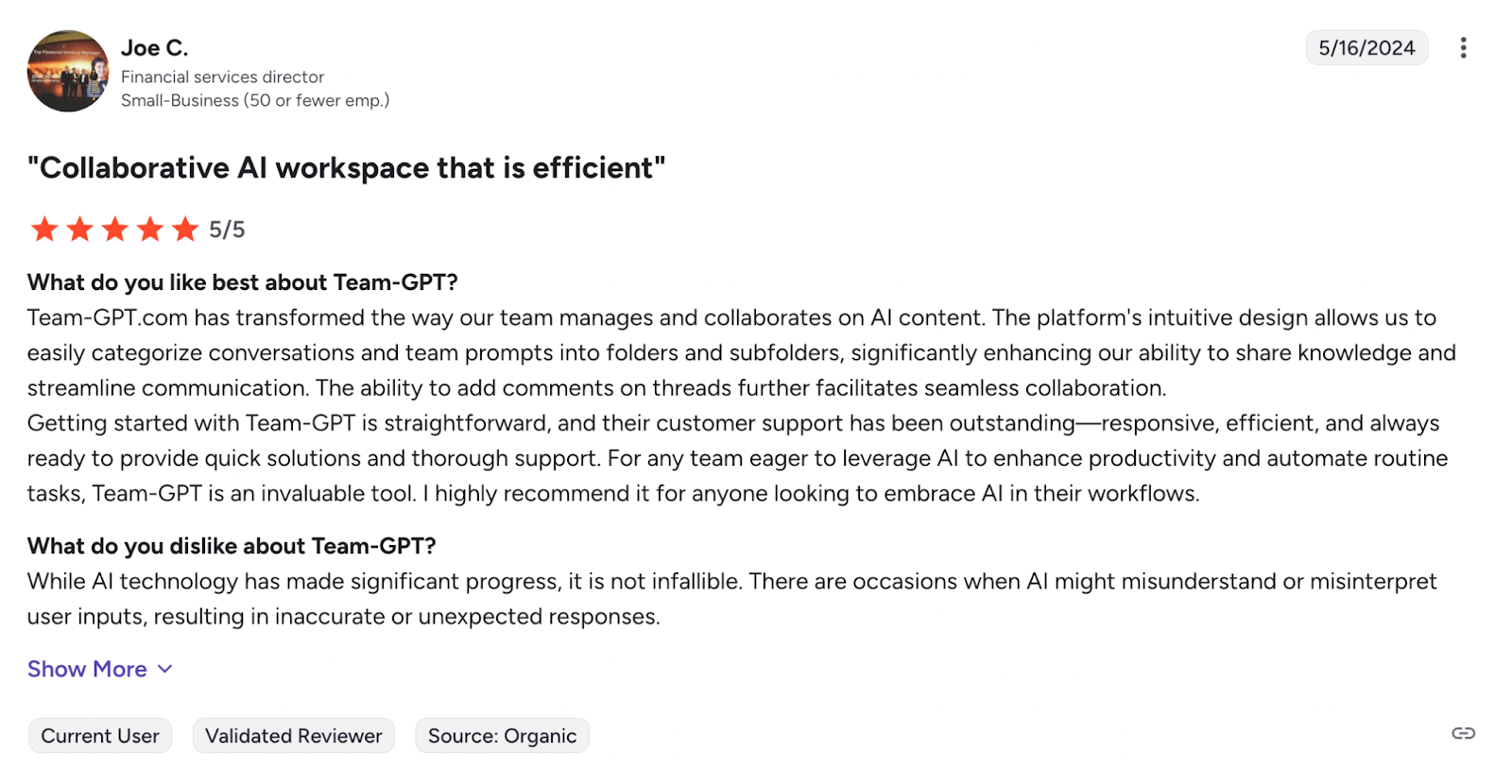
“The platform’s intuitive design allows us to easily categorize conversations and team prompts into folders and subfolders, significantly enhancing our ability to share knowledge and streamline communication.” – G2 Review.
Common complaints:
- Occasional Misinterpretations by AI: Some users mention that the AI may not always understand inputs correctly. This can lead to responses that feel off-topic or inaccurate, especially for nuanced queries.
- Initial Learning Curve For New Users: While the platform is built for ease of use, a few users noted that there’s a short adjustment period before teams become fully comfortable using all features.
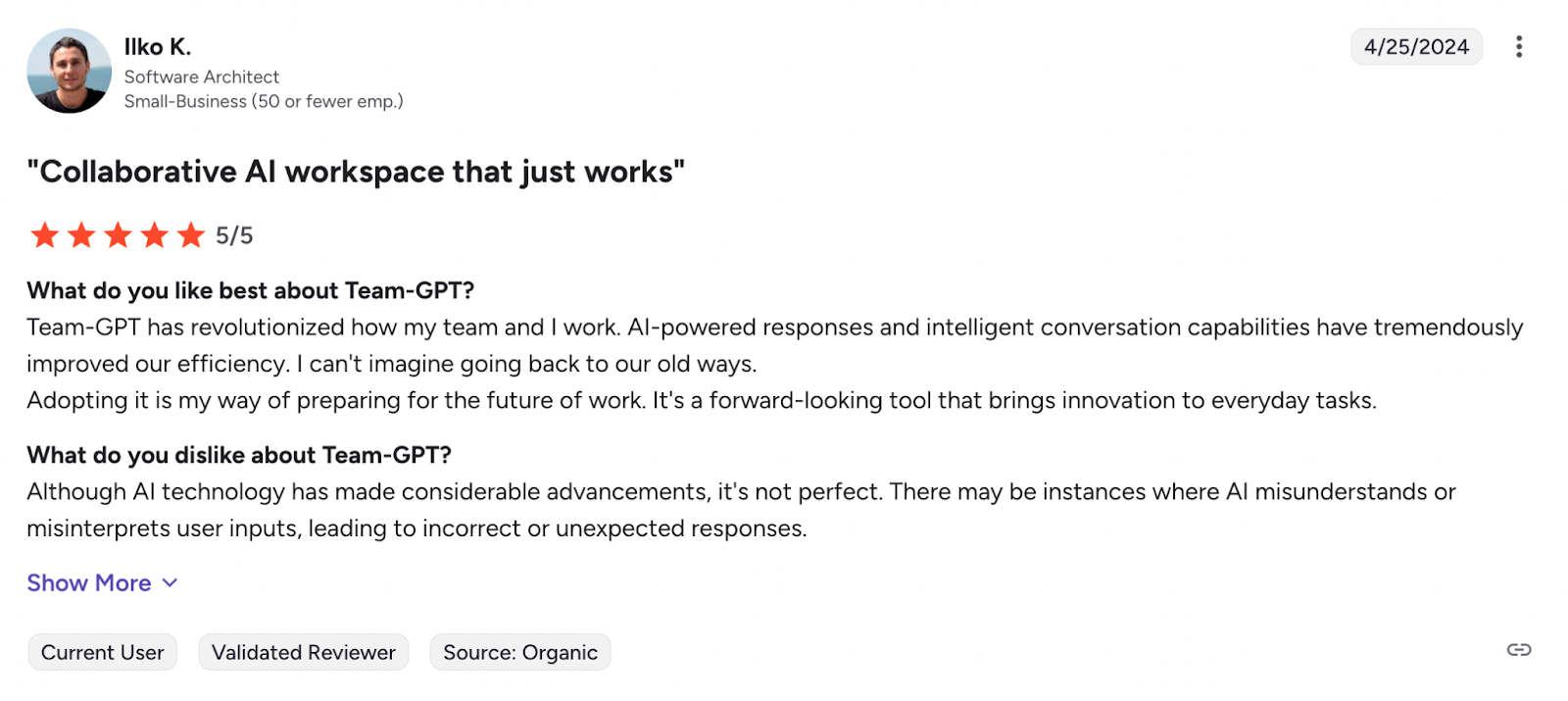
“Although AI technology has made considerable advancements, it’s not perfect. There may be instances where AI misunderstands or misinterprets user inputs, leading to incorrect or unexpected responses.” – G2 Review.
Claude Teams Reviews
What users love:
- Strong Analytical Thinking: Claude is especially praised for its ability to interpret complex data. Users say it can generate summaries from tables, extract key insights, and assist in planning tasks with minimal manual input.
- Helpful for Strategic Planning: Reviewers find Claude particularly useful for breaking down large goals into smaller, actionable steps. This makes it popular for financial planning, project management, and goal setting.

“Claude does a great job with tables and charts — it actually makes sense of the data and pulls out the key points without much effort on my end. It’s also really helpful for digging into financials, planning ahead, and breaking big goals into smaller, manageable steps.” – G2 Review.
Common complaints:
- Less Flexible for Small Teams: A major issue flagged by users is that Claude Teams requires a minimum of 5 seats, making it inaccessible for smaller teams or solo professionals. This rigidity has caused frustration for those trying to explore alternatives.
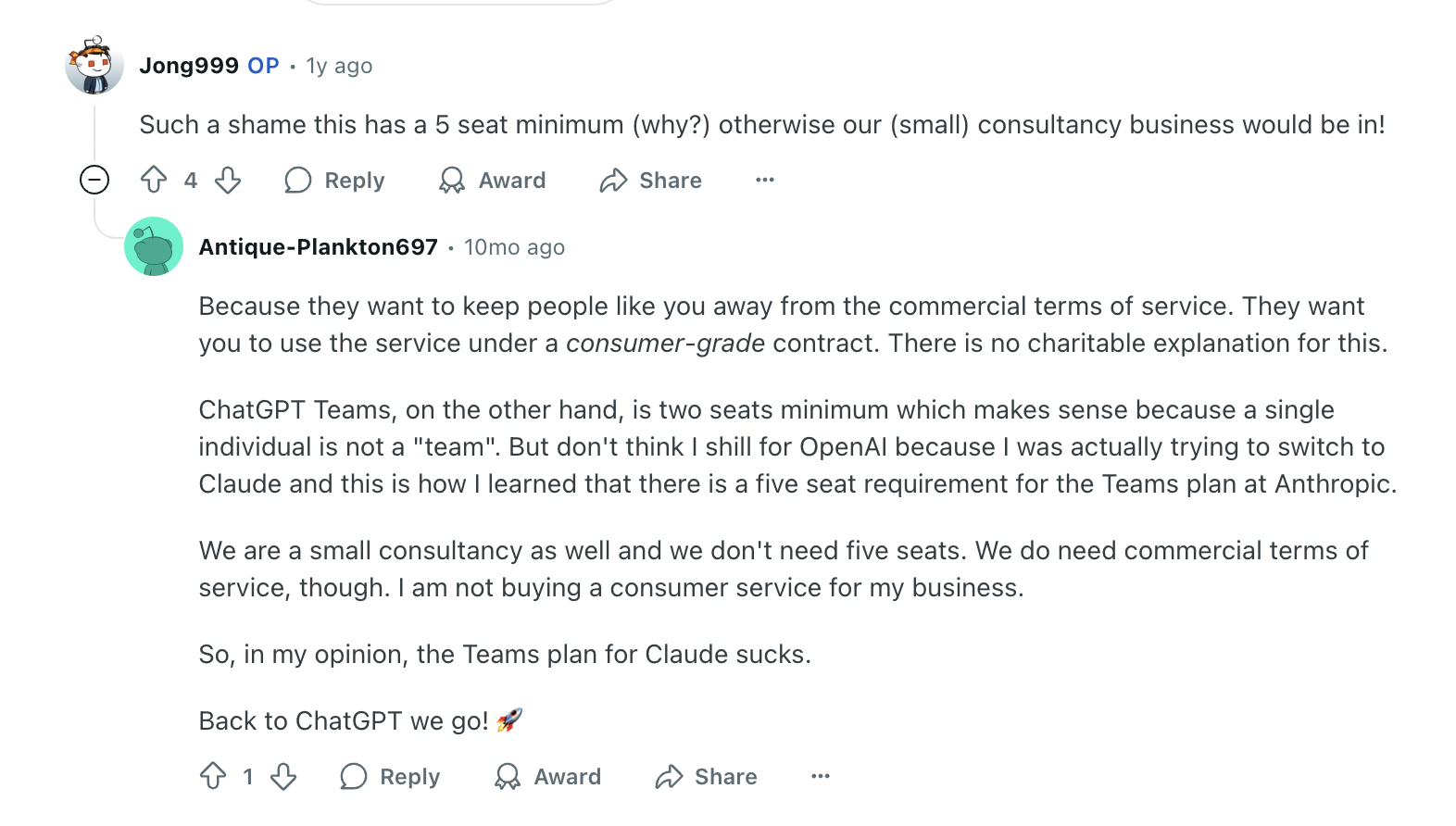
“Don’t think I shill for OpenAI because I was actually trying to switch to Claude and this is how I learned that there is a five seat requirement for the Teams plan at Anthropic. We are a small consultancy as well and we don’t need five seats. We do need commercial terms of service, though. I am not buying a consumer service for my business.” – Reddit Review.
Final Verdict: Team-GPT or Claude Teams?
The right platform depends on how deeply your team plans to integrate AI into marketing workflows.
Claude Teams offers strong reasoning capabilities and a clean interface, but it comes with some key limitations. It doesn’t support image generation, offers fewer customization options, and may not match OpenAI’s models in terms of versatility, especially for teams that need broader creative or operational output.
Team-GPT, on the other hand, is built specifically for teams and businesses. It supports multiple AI models (including ChatGPT and Claude), allows easy collaboration, and gives you control over prompts, workflows, and team usage. You can also integrate your models, track activity, and maintain enterprise-grade data privacy, making it ideal for teams serious about AI adoption.
If your goal is to scale AI use across functions, keep workflows centralized, and have the flexibility to use the best model for each task, Team-GPT is the more complete choice.
Wrapping Up
Both Claude Teams and Team-GPT are solid AI tools, but they serve different priorities.
If your main focus is casual use or exploring Claude’s natural language strengths in a clean, distraction-free space, Claude Teams does the job. But for growing teams that need structure, flexibility, and deeper collaboration, it may feel a bit limiting.
Team-GPT is built with team workflows in mind. Whether you’re running campaigns, writing content, or streamlining internal processes, it helps teams stay aligned, reuse prompts, and manage projects with shared context. From solo marketers to cross-functional teams, it scales with how you work.
Ultimately, the right pick comes down to how much collaboration and control you need.
Next Steps For Enterprises Looking To Adopt AI
If your team is ready to scale its AI usage beyond basic experimentation, now’s the time to implement a solution that supports structure, security, and cross-functional collaboration. Team-GPT is built for teams that want to integrate AI deeply into their workflows, whether for marketing, content creation, analytics, or internal operations.
For example, SaaS Group, a network of SaaS businesses that adopted Team-GPT to unify AI usage across departments. With over 180 users, they implemented prompt templates for sales, marketing, and engineering, while maintaining strict privacy controls. This resulted in over 50,000 hours saved annually through smarter automation and streamlined collaboration.

Book a demo with one of our AI adoption experts and see how Team-GPT can be tailored to your team’s needs.
Read More
- How to Create META Ads Copy with Team-GPT: Learn how to generate compelling META ad copy that’s tailored to your audience and optimized for performance.
- How to Create Google Ads Copy with Team-GPT: Use Team-GPT to write high-converting Google Ads in minutes based on your goals, keywords, and CTAs.
- Create Pro Social Media Posts with Team-GPT: Quickly draft engaging posts for any platform with Team-GPT’s templates, tone selection, and formatting tools.
- Create High-Quality LinkedIn Posts with Team-GPT: Build thought-leadership content and personal updates that actually perform on LinkedIn.
- Optimize Articles for SEO in minutes with Team-GPT: Refine existing blogs or write new ones that are keyword-rich and structured for search visibility.
- Analyze Marketing Campaigns in Minutes with Team-GPT: Break down what’s working (and what’s not) across your campaigns using uploaded reports and instant insights.
- How to turn videos into multiple content pieces with Team-GPT: Repurpose any video into blogs, captions, carousels, and emails in just a few clicks using Team-GPT.

